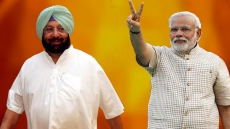India on Wednesday successfully put into orbit an earth observation satellite that can see through thick clouds and enhance the country’s surveillance capabilities in military and civilian sectors to keep an eye also on terror camps across the border in Pakistan.
Dubbed as a ‘spy’ satellite, RISAT-2B (Radar Imaging Satellite-2B) will replace its predecessor RISAT-2 which has been actively used by India to monitor activities in terror camps across the border in Pakistan to thwart infiltration bids by terrorists. RISAT was successfully launched in 2009.
The RISAT-2B is equipped with a synthetic aperture radar that can take pictures of the earth during day and night, and also under cloudy conditions, said an official of the Indian Space Research Organisation (ISRO).
With a mission life of five years, the satellite will also be used for military surveillance, the official said.
As the 25-hour countdown which began Tuesday concluded, ISRO’s trusted workhorse, the Polar Satellite Launch Vehicle (PSLV-C46) blasted off at 5.30 am from the first launch pad of the Satish Dhawan Space Centre here on its 48th mission, carrying the 615 kg satellite.
The satellite, which is meant for application in fields such as surveillance, agriculture, forestry and disaster management support, was successfully released into its orbit at about 15 minutes and 30 seconds after the lift-off.
Commenting on the launch from the Mission Control Centre, ISRO Chairman K Sivan said the PSLV-C46 successfully injected RISAT-2B precisely in the designated orbit of 555 km, with an inclination of 37 degrees.
“This particular mission for PSLV is a very, very important mission. With this launch, PSLV lofts 50 tonnes to space by launching 354 satellites, including national, student and foreign satellites,” Sivan said.
The ISRO chairman said the PSLV-C46 carried two important piggyback payloads, an indigenously developed processor and a low cost Inertial Navigation System.
The two payloads—Vikram processor and low-cost MEMS-based Inertial Navigation System (INS) -- were developed by Semi-Conductor Laboratory (SCL), Chandigarh and ISRO Inertial Systems Unit, Thiruvananthapuram respectively, he said.
“It is going to revolutionise our future launch vehicle missions” he said.
Sivan said the RISAT-2B is an advanced earth observation satellite. “In this satellite, another very complex new technology has flown. That is a 3.6 metre unfurlable radial rib antenna. This is also going to be the technology of the future,” he added.
Hours after the Wednesday launch, the ISRO said the telemetry tracking and command network in Bengaluru has assumed control of the satellite.
“After separation, solar arrays of RISAT-2B were deployed automatically and ISRO Telemetry Tracking and Command Network (ISTRAC) at Bengaluru assumed control of the satellite,” an ISRO statement said.
“In the coming days, the satellite will be brought to its final operational configuration,” it added.
On future launches, Sivan said, “The next mission—Chandrayaan-2 -- is going to be a landmark mission for India. It is going to be the most complex mission ever undertaken by ISRO. It is going to take place between July 9 and July 16 this year.”
He added that the landing on the moon is expected to be on September 6. “It is going to land at a particular location where nobody has gone before.”
After Chandrayaan-2, Sivan said, “ISRO would look at launching the very high resolution CARTOSAT 3 satellite.”
“A second demonstration of the reusable launch vehicle is going to happen in the coming months. Cost effective small satellite launch vehicle developments are also going to take place in a few months from now,” he added.
The PSLV-C46 was the 14th flight of the PSLV in its core-alone configuration sans the use of the solid strap-on motors.
It was the 72nd launch vehicle mission from Sriharikota and also marked the 36th launch from the first launch pad.
Wednesday’s launch of the PSLV also marked the third launch in 2019.
The other two were the PSLV-C45/EMISAT mission, which successfully injected the EMISAT and 29 international customer satellites into their orbits on April 1, and the PSLV-C44, which successfully placed the Microsat-R and the Kalamsat-V2 satellites in designated orbits on January 24.
ISRO had launched RISAT-1, a microwave remote sensing satellite, on April 26, 2012 from Sriharikota.



